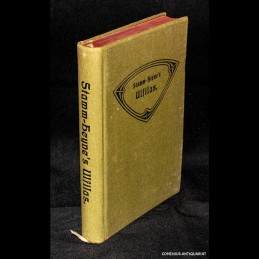Wrede, Ferdinand [Hrsg.],
Stamm-Heyne's Ulfilas oder die uns erhaltenen Denkmäler der gothischen Sprache. Text, Grammatik, Wörterbuch. 12. Auflage. Paderborn : Ferdinand Schöningh, 1913. XXVI, 493 Seiten. Leinen mit Rotschnitt und Lesebändchen. 212 x 140 mm. 755 g
* Neu herausgegeben von Ferdinand Wrede.
Bestell-Nr.159166
Stamm-Heyne's |
Literaturwissenschaft allgemein |
Sprachwissenschaft |
Linguistik |
Lexika |
Dictionary
Inhalt.
Vorwort ix
Einleitung' xv
Wichtigste Literatur.xxv
Die gotischen Sprachdenkmäler. 1
Die Evangelien. 3
Matthäus 8. 3 — Marcus S. 22 — Lucas S. 62 —
Johannes 8. 116
Die Briefe Pauli. 154
Röm. 8. 154 — 1. Corinth. S. 168 — 2. Corinth. S. 184
— Galat. 8. 205 — Ephes. 8. 214 — Philipp. 8. 225 —
Coloss. 8. 231 — 1. Thessal. 8. 237 — 2. Thessal. 8. 243
— 1. Timotheus 8. 247 — 2. Timotheus 8. 256 —
Titus 8. 262 — Philem. 8. 264
Bruchstücke des Alten Testaments 265
Skeireins 268
Kalender 276
Urkunden 277
Grammatik 281
§ 1. Germanen und Goten283
§ 2. Sprache und Überlieferung der gotischenBibel . 283
§ 3. Die gotische Schritt und ihre moderne Trans-
scription 284
§ 4. Zum Lautwert der gotischen Buchstaben . . . 286
§ 5. Zum Zahlenwert der gotischen Buchstaben . . 287
Lautlehre . 288
Kap. I. Vocalismus
1. Statistischer Teil.288
a 8. 288 — e S. 289 — i 8. 290 —
u 8. 291 — y S. 292 — o 8. 293 —
ai 8. 293 — au 8. 295 — ei S. 297
- iu 8. 297
2. Historischer Teil 298
Ablaut 8. 298 — Vocalisches Auslauts
gesetz 8. 301
Kap. II. Consonantismus
1. Statistischer Teil 302
Halbvocale (j, w) 8. 302 — Labiale (p,
b, f) 8. 305 — Dentale (t, d, p, z, s)
S. 307 — Gutturale (k, x, q, g, h, liw)
S. 310 — Liquiden und Nasale (l, r, m,
n) 8. 313
VI Inhalt.
Seite
2. Historischer Teil313
Grammatischer Wechsel S. 314 — ft, ht,
•ss (st) 8. 315 — Consonantisches Aus
lautsgesetz S. 317
Zur Wortbildungslehre.318
Präfixe S. 318 — Nominale Composition
S. 321 — Suffixe S. 323
Formenlehre 326
Kap. I. Conjugation
A. Allgemeines 326
ß. Starke Verba
1. Tempusbildung 327
a) Ablautende Verba 8. 328 — b) Re-
duplicierende Verba S. 329 — c) Re-
duplicierend-ablautende Verba 8. 331
2. Flexionsendungen. 331
C. Schwache Verba
1. Stammbildung. 333
a) -Jan 8. 333 — b) -an S. 334 —
c) -on 8. 335 — d) -nan 8. 335
2. Flexionsendungen. 337
a) -Jan 8. 337 — b) -an 8. 339 —
c) -on S. 339 — d) -nan 8. 340
D. Verba anomala
1. Verba praeterito-praesentia 340
2. Verba in mi 342
Kap. II. Declination
A. Allgemeines 343
B. Substantiva
1. Vocalische Declination. 344
a) a-Decl. 8. 344 — b) o-Decl. 8. 347
— c) r-Decl. 8. 347 — d) w-Decl. 8. 349
2. Consonantische Declination 349
a) Schwache Deel. 8. 350 — b) Ano
mala 8. 351
3. Declination der Eigennamen und Fremd
wörter 353
C. Adjectiva
1. Starke Declination.356
a) a- und o-Decl. S. 357 — b) a-Decl.
8. 358 — c) w-Decl. 8. 359
2. Schwache Declination. 360
3. Comparation 361
D. Zahlwörter
1. Cardinalia. 362
2. Ordinalia 364
3. Andere Zahlenbildungen 365
E. Pronomina
1. Die ungeschlechtigen Personalia . . . 365
2. Possessiva. 366
3. Geschlechtiges Pronomen der dritten
Person 366
4. Demonstrative. . . . 367
Inhalt. VII
5. Belativa.368
6. Interrogativa 369
7. Indefinita 370
Kap. III. Partikeln
A. Adverbia. 371
B. Präpositionen. 373
C. Conjunctionen. 374
D. Interjectionen. 375
Zur Syntax376
Kap. I. Zur Conjugation
A. Genera verbi 377
B. Tempora 377
C. Modi. 378
1. Indicativ. 378
2. Optativ. 379
3. Imperativ 380
D. Numeri 381
E. Verbalnomina
1. Infinitiv. 381
2. Participia.382
Kap. II. Zur Declination
A. Genera 383
B. Numeri 384
C. Casus
1. Genitiv. 385
2. Dativ 387
3. Accusativ 390
D. Zu einzelnen Wortklassen
1. Adjectiva 391
2. Pronomina und Artikel . . . . 393
Wörterbuch. 395






 Privacy
Privacy
 Shipping Costs
Shipping Costs
 Google Mail
Google Mail
